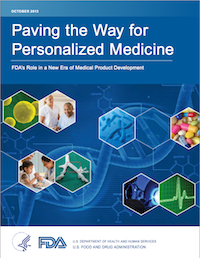FDA has just released a new report that seeks to define the agency’s “unique role and responsibilities” in personalized medicine. The introduction of the report provides an excellent overview of the topic of personalized medicine, and then goes into considerable detail covering the agency’s history with products used in personalized healthcare. The report concludes by describing basic challenges in the field.

Once again the point was made that the “success of personalized medicine depends on the development of accurate and reliable diagnostics,” and that biomarkers facilitate such tests.
The report also reaffirms the agency’s belief that LDTs require additional regulatory oversight, and even states that FDA is aware of cases involving faulty tests causing hard to patients. While no specific guidelines or timelines are provided, the report states that “FDA has been developing a risk-based framework for regulatory oversight of LDTs.” The Agency also seems to recognize that lack of consistency in IVD regulation is a drag on the market with the conclusion that “FDA believes that clarifying the regulatory oversight framework for IVDs would facilitate the development of in vitro diagnostic tests…”
In the conclusion the report identifies the primary challenges facing personalized medicine, and the first one identified is a lack of basic biological understanding. “The tools of the last two decades have left us awash in data, yet we still have a relatively limited understanding of what it all means.” Analytical tools clearly remain the most critical need for the advancement of personalized medicine.
Progress for Personalized Medicine
The report concludes with the statement “From FDA’s vantage point, the era of personalized medicine has clearly arrived,” and by way of support states that of the drugs approved since 2011, “approximately one-third had some type of genetic or other biomarker data included in the submission to characterize efficacy, safety, or pharmacokinetics.”

This is progress indeed.
Our only frustration as a company that likes to follow trends is our inability to understand the scope of the LDT market. FDA clearances and approvals of IVDs are limited indeed, and the growth of LDTs is considerable and challenging to measure.
